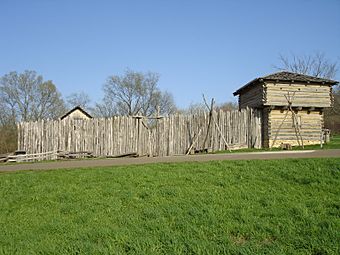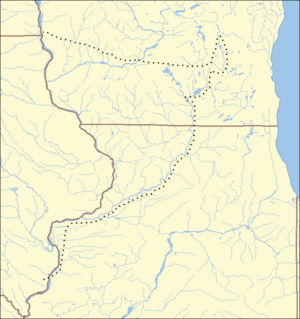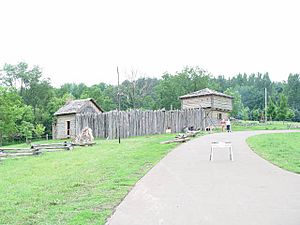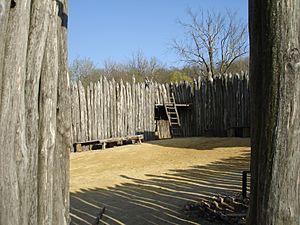Apple River Fort facts for kids
Quick facts for kids |
|
|
Apple River Fort Site
|
|

Reconstruction of the fort
|
|
| Nearest city | Elizabeth, Illinois |
|---|---|
| Area | 0.5 acres (0.20 ha) |
| Built | 1832 |
| NRHP reference No. | 97001332 |
| Added to NRHP | November 7, 1997 |
The Apple River Fort, now known as the Apple River Fort State Historic Site, was a frontier fort built quickly by settlers in northern Illinois and southern Wisconsin. This happened when the Black Hawk War began in 1832. The fort is located in Elizabeth, Illinois, United States. Settlers built it in less than a week.
It was one of the few forts attacked during the war. It was also the only one attacked by a group led by Black Hawk himself. During the Battle of Apple River Fort, there was a fight that lasted about an hour. Black Hawk's forces eventually left. One militia man was killed, and another was hurt. After the war, the fort stood until 1847. People lived there without owning the land before it was sold and taken apart.
Today, a copy of the fort stands near where the original fort was. A non-profit group built this replica between 1996 and 1997. They used information from old digs at the site to learn how the fort was built. In 1997, the Apple River Fort Site was added to the National Register of Historic Places. In 2001, the state of Illinois took over the site. They named it the Apple River Fort State Historic Site.
The Apple River Fort was one of many Illinois historic sites that faced closure in 2008. This was due to budget cuts by the state governor at the time. After the governor was removed from office, the new governor reopened the site in May 2009.
Contents
History of the Fort
Early Settlers and the Fort's Beginnings
The first people to settle near Apple River Fort were likely miners. They probably arrived more than ten years before the fort was built. These miners made their homes and built log cabins along Kellogg's Trail. This trail was a path from Galena to Dixon's Ferry. They got fresh water from a nearby spring.
Why the Black Hawk War Started
| Map of Black Hawk War sites Symbols are wikilinked to article |
The Black Hawk War caused the fort to be built. This war happened because of a treaty made in 1804. This treaty was between the Governor of the Indiana Territory and leaders from the Sauk and Meskwaki tribes. The treaty gave about 50 million acres of Sauk and Meskwaki land to the United States. In return, the tribes received $2,234.50 and $1,000 each year.
Sauk Chief Black Hawk and others did not agree with the treaty. They said that the full tribal councils were not asked. They also said the leaders who signed the treaty did not have the power to give away land. The treaty also said the Sauk and Meskwaki could stay on their land until it was sold.
In the 1820s, lead was found near Galena, Illinois. Miners then started moving onto the land from the 1804 treaty. When the Sauk and Meskwaki returned from their winter hunt in 1829, they found white settlers on their land. They were forced to move west of the Mississippi River. Black Hawk was angry about losing his birthplace. From 1830 to 1831, he led groups across the Mississippi several times. Each time, he was convinced to go back without fighting.
In April 1832, Black Hawk moved his "British Band" of about 1,000 people, including warriors and families, into Illinois. He thought other tribes and the British would help him. But he found no allies and tried to return to Iowa. However, the actions of the Illinois militia led to the Battle of Stillman's Run. After this first fight, the Apple River Fort was built very quickly. More battles followed, and militias from Michigan Territory and Illinois were called to find Black Hawk's Band.
Building the Fort for Protection
Settlers in the area built the Apple River Fort for protection during the 1832 Black Hawk War. After the Illinois Militia lost at Stillman's Run on May 14, settlers quickly built forts and fortified homes. The Galenian newspaper reported that the main blockhouse was finished by May 22, 1832. The surrounding stockade was completed a few days later.
Local families and single men formed a militia company. They chose Clack Stone, a local surveyor, as their captain. At the time the fort was finished, several families lived in the Apple River settlement. These included the Crains and the Armstrongs. Other families, like the Flacks and Howards, lived in nearby cabins. The Murdock family already had a home near the new fort.
There are not many old descriptions of the fort. One detailed description from 1878, after the war, tells us about it: Trees were cut down and brought to the area. Workers dug a three-foot trench for the stockade walls. Each log was placed upright and buried to stand about twelve feet high. Two walls of an existing log house formed one corner of the fort. In the opposite corner, a two-story blockhouse was built. The second story hung over the first by about two feet. This made it hard for attackers to get close to set it on fire. Settlers could shoot down from above. Two long cabins inside the fort were used for living. In the other two corners, elevated platforms called "bastions" were built into the log wall. These were used for standing and looking out.
The Battle at Apple River Fort
Black Hawk and 200 warriors attacked the fort on the afternoon of June 24, 1832. About thirty men and boys defended the fort. There were also about 40 women, children, and babies inside. A messenger named Edmund Welch was shot in the hip early in the fight.
The battle lasted about an hour. The Illinois Militia at Apple River Fort had only one death, George W. Harkleroad. Josiah Nutting was wounded. During the battle, several women helped defend the fort. Elizabeth Armstrong was especially brave. She encouraged the settlers, especially the women, to support the defenders. We do not know how many of Black Hawk's warriors were hurt.
What Happened After the War
After the war, the fort remained standing into the 1840s. Right after the war, two people who did not own the land lived there. In 1847, George Bainbridge bought the land and the fort from the United States federal government. Bainbridge took apart the fort and used the good logs to build a barn. The fort site was mostly left alone for many years.
In 1994, a non-profit group called the Apple River Historical Foundation was formed. They started an archaeological dig in 1995. In June 1997, they finished building a replica of the fort. Today, this replica stands south of the original site. The original site is left untouched to protect its historical remains.
The state historic site at Apple River Fort was supposed to close on October 1, 2008. This was due to budget cuts by the Illinois governor at the time. Supporters of the site protested, worried about how the closing would affect the community. The plan to close several state parks and historic sites, including Apple River Fort, went ahead on November 30, 2008. After the governor was removed from office, the new governor reopened the closed state parks in February 2009. In March 2009, he promised to reopen the state historic sites by June 30, 2009.
Finding the Old Fort: Archeology
The Apple River Fort Historic Foundation started looking for the original fort site in the spring of 1995. Local stories said the fort was on a hill near Main Street in Elizabeth. The group hired an archaeologist to find the old fort.
Floyd Mansberger led the archaeological digs in the summer of 1995. He worked with the Illinois Historic Preservation Agency. First, they walked over the site. They found some items from before the American Civil War. Then, they lightly tilled the soil to collect items from the surface. They found many different things. These included glass, ceramics, personal items, and small pieces of brick and stone. These items showed that people lived at the Apple River Fort site in the early 1800s. It seemed they lived there for a short time, probably not past 1860.
The dig found the original shape of the fort. It was smaller than expected, about 50 feet by 70 feet. This work greatly helped us understand the early Apple River settlement. The archaeologists' findings allowed for the replica to be built starting in 1996. Volunteers built the fort using the same tools and materials settlers would have used. They stripped and split logs by hand. They also split shingles by hand. A trench was dug to connect the two cabin replicas inside. The stockade walls were built with 14 and 15-foot long logs. Volunteers also built a blockhouse and firing stands with hand-carved ladders.
Fort Design and Layout
During the archaeological study, Apple River Fort was found to be built very similarly to Fort Blue Mounds. Fort Blue Mounds was another Black Hawk War fort in Wisconsin. The main difference was where buildings were placed inside the stockade. The digs at Apple River found twelve original features of the fort.
They found the remains of four cellars inside the fort. One in the southeast corner might have stored food or processed dairy. In the northwest corner, there were two more cellars, west of one of the log buildings. The largest cellar was under the fort's blockhouse, in its southeast corner. This cellar was used as a trash pit into the 1840s. The oldest items found at the site came from the blockhouse cellar.
Why the Fort is Important Today
The Apple River Fort was important in the 1832 Black Hawk War. It was one of the few forts attacked during the conflict. It was also the only fort attacked by a group led by Black Hawk himself. The original fort site still holds many important archaeological items and information underground.
Because of its military and archaeological importance, the Apple River Fort Site was added to the U.S. National Register of Historic Places on November 7, 1997. On January 1, 2001, the state of Illinois took over running the rebuilt Apple River Fort and its visitor center. The state now manages the area as the Apple River Fort State Historic Site. Illinois bought the site partly with a US$160,000 grant.
See also






